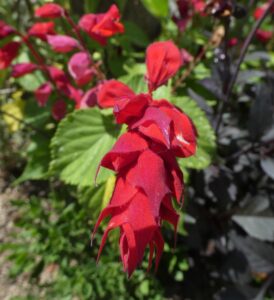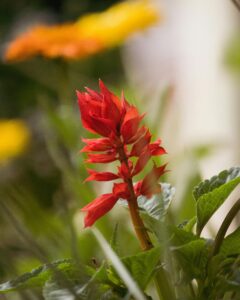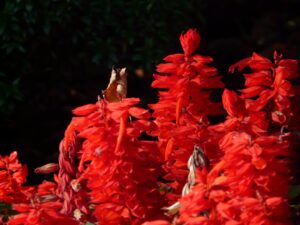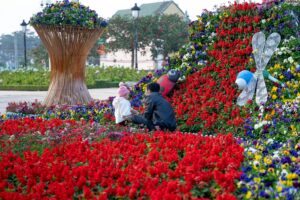Red Salvia, scientifically known as Salvia splendens, is a popular flowering plant cherished for its vibrant blooms and attractive foliage. Red Salvia, a member of the mint family (Lamiaceae), is native to Brazil but is cultivated worldwide as an ornamental plant. It is renowned for its stunning red flowers, which appear in dense spikes and create a striking display in gardens, borders, and containers.

Red Salvia typically grows to heights ranging from 12 to 36 inches (30 to 90 cm), depending on the cultivar and growing conditions. The plant produces elongated spikes of tubular, two-lipped flowers that form dense clusters called racemes. While red is the most common color, cultivars with pink, purple, white, or bicolor blooms are also available.
Salvia plant features lush green foliage composed of ovate to lanceolate leaves with serrated edges. The foliage provides an attractive backdrop to the vibrant blooms and remains visually appealing even when the plant is not in flower. Red Salvia exhibits an upright growth habit, forming bushy clumps of foliage that are adorned with profuse blooms during the growing season.

With its stunning blooms, easy cultivation, and versatility in the garden, Salvia is a beloved plant among gardeners and flower enthusiasts, bringing joy and vibrancy to any landscape.
Sunlight Requirement
Red Salvia thrives in full sun exposure, although it can tolerate partial shade. For optimal growth and flowering, it is recommended to plant Salvia in a location that receives at least 6 to 8 hours of direct sunlight per day.

Temperature and Humidity Requirement of Red Salvia
Red Salvia generally prefers warm temperatures and can tolerate a wide range of temperatures, but it performs best in moderate to warm conditions. Ideally, the temperature for Red Salvia should be between 65°F to 80°F (18°C to 27°C) during the day and no lower than 50°F (10°C) at night.
As for humidity, Salvia plant is relatively adaptable and can tolerate different humidity levels. However, it tends to prefer moderate humidity levels, ideally between 40% to 60%.
Soil Requirements
Red Salvia thrives in well-draining soil that is rich in organic matter. The ideal soil for Red Salvia is loamy and slightly acidic to neutral, with a pH level between 6.0 and 7.0. Good drainage is essential to prevent waterlogging, which can lead to root rot and other problems.

Red Salvia Propagation
To sow Red Salvia seeds for propagation, follow these steps:
Use a well-draining seed-starting mix or a combination of peat moss and perlite. Fill seed trays or small pots with the soil mixture, leaving about 1/4 inch of space at the top.
Place Red Salvia seeds on the soil surface, spacing them about 1 inch apart. Gently press the seeds into the soil, but do not bury them deeply, as they require light to germinate.
Mist the soil surface with water until it is evenly moist. Avoid saturating the soil, as excess moisture can lead to fungal problems. Keep the soil consistently moist throughout the germination period.
Place the seed trays or pots in a warm location with temperatures around 70-75°F (21-24°C). You can use a heating mat to maintain consistent warmth if needed.
Red Salvia seeds require light to germinate, so ensure they receive bright, indirect light. Avoid placing them in direct sunlight, as this can cause overheating.
Red Salvia seeds typically germinate within 10-14 days, although it may take longer in some cases. Continue to keep the soil moist and provide adequate warmth and light during this time.
Once the Red Salvia seedlings have developed several true leaves and are sturdy enough to handle, they can be transplanted into individual pots or the garden bed. Harden off the seedlings gradually before transplanting them outdoors to acclimate them to outdoor conditions.

By following these steps, you can successfully sow Red Salvia seeds for propagation and grow healthy seedlings for transplanting into your garden.
Water Requirements
Red Salvia generally prefers moderately moist soil but is somewhat drought-tolerant once established. During the initial planting and establishment phase, keep the soil consistently moist but not waterlogged. Water deeply immediately after planting to help the roots establish. Water when the top inch of soil feels dry to the touch. Once Red Salvia plants are established, they can tolerate some dryness between waterings.
Fertilizer Requirement of Red Salvia
To ensure healthy growth and prolific blooming, Red Salvia plants benefit from regular fertilization. Begin fertilizing salvia plants in early spring, just as new growth starts to emerge. Continue fertilizing throughout the growing season until late summer or early fall. Use a balanced, water-soluble fertilizer formulated for flowering plants.

In containers or hanging baskets, where nutrients may leach out more quickly, you may need to fertilize salvia plants more frequently. Follow the specific recommendations for container plants provided on the fertilizer package.
Problems while growing Red Salvia
While Red Salvia is generally easy to grow, it can encounter a few problems that may affect its health and appearance. Here are some common issues encountered when growing Red Salvia:
Powdery Mildew: Red Salvia is susceptible to powdery mildew, a fungal disease that appears as a white powdery coating on the leaves. To prevent powdery mildew, ensure good air circulation around the plants, avoid overhead watering, and space plants adequately to reduce humidity levels.
Pests: Aphids, spider mites, and whiteflies are common pests that may attack on salvia plants. These pests feed on plant sap, causing stunted growth, yellowing leaves, and distorted foliage. Use insecticidal soap or neem oil to control minor infestations, and prune heavily infested plant parts.
Heat Stress: High temperatures, especially combined with humidity, can cause stress to Red Salvia plants, leading to wilting and reduced flowering. Provide shade during the hottest part of the day and ensure adequate moisture to help plants withstand heat stress.
Soil pH: Salvia prefers slightly acidic to neutral soil pH (around 6.0 to 7.0). Soil that is too acidic or alkaline can affect nutrient availability and plant health. Test the soil pH and amend it if necessary to maintain optimal growing conditions for Red Salvia.
Fungal Diseases: Besides powdery mildew, Salvia may also be susceptible to other fungal diseases such as leaf spot and rust. Ensure good air circulation, avoid overhead watering, and remove and destroy infected plant debris to prevent the spread of fungal spores.

By monitoring your Red Salvia plants regularly and addressing any issues promptly, you can help keep them healthy and thriving throughout the growing season.


